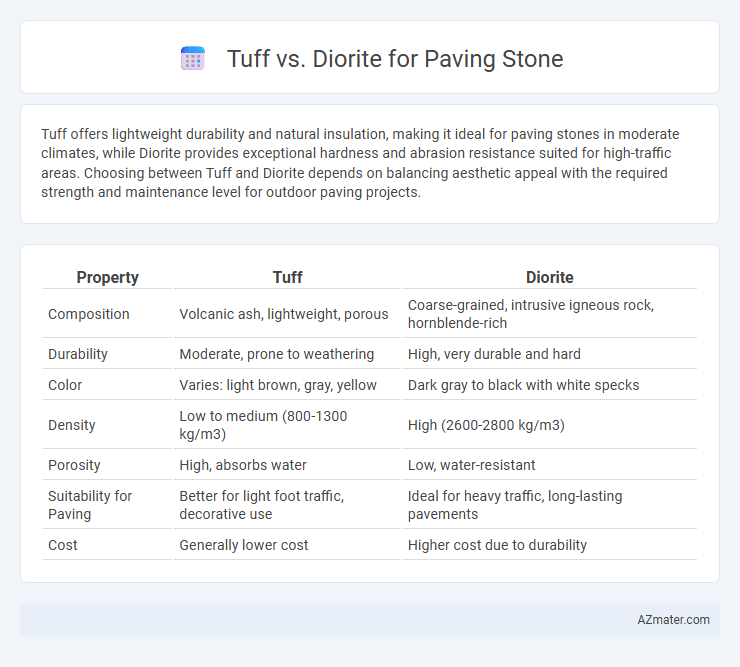Tuff offers lightweight durability and natural insulation, making it ideal for paving stones in moderate climates, while Diorite provides exceptional hardness and abrasion resistance suited for high-traffic areas. Choosing between Tuff and Diorite depends on balancing aesthetic appeal with the required strength and maintenance level for outdoor paving projects.
Table of Comparison
| Property | Tuff | Diorite |
|---|---|---|
| Composition | Volcanic ash, lightweight, porous | Coarse-grained, intrusive igneous rock, hornblende-rich |
| Durability | Moderate, prone to weathering | High, very durable and hard |
| Color | Varies: light brown, gray, yellow | Dark gray to black with white specks |
| Density | Low to medium (800-1300 kg/m3) | High (2600-2800 kg/m3) |
| Porosity | High, absorbs water | Low, water-resistant |
| Suitability for Paving | Better for light foot traffic, decorative use | Ideal for heavy traffic, long-lasting pavements |
| Cost | Generally lower cost | Higher cost due to durability |
Introduction to Tuff and Diorite as Paving Stones
Tuff, a lightweight volcanic rock formed from compacted volcanic ash, offers excellent thermal insulation and is easy to cut, making it a popular choice for paving stones in landscaping projects. Diorite, an intrusive igneous rock known for its coarse texture and high durability, provides a robust and wear-resistant surface ideal for heavy-traffic paving applications. Both tuff and diorite exhibit unique mineral compositions that influence their aesthetic and functional performance in paving stone installations.
Geological Formation: Tuff vs Diorite
Tuff forms from the consolidation of volcanic ash ejected during explosive volcanic eruptions, resulting in a porous, lightweight rock often composed of fragmented volcanic material and crystals. Diorite is an intrusive igneous rock that crystallizes slowly beneath the Earth's surface, characterized by a coarse-grained texture composed primarily of plagioclase feldspar and hornblende. The distinct geological origins influence their durability and appearance, with diorite typically offering greater hardness and density compared to the softer, more porous tuff often selected for its aesthetic volcanic texture.
Physical Properties Comparison
Tuff exhibits lower density and compressive strength compared to diorite, making it more lightweight but less durable under heavy loads. Diorite's higher hardness and resistance to abrasion ensure greater longevity and minimal wear for paving applications. Thermal conductivity is typically higher in diorite, contributing to better heat resistance on paved surfaces.
Durability and Strength Analysis
Tuff, formed from volcanic ash, offers moderate durability and is relatively softer compared to diorite, making it more susceptible to wear and erosion over time when used as paving stone. Diorite, an intrusive igneous rock composed mainly of feldspar and quartz, exhibits superior strength and high resistance to abrasion, providing enhanced longevity and structural integrity for heavy-traffic paving applications. The mineralogical composition and density differences result in diorite outperforming tuff in load-bearing capacity and durability under extreme weather conditions.
Aesthetic Appeal and Color Variations
Tuff offers a unique aesthetic appeal with its porous texture and natural earth tones ranging from soft yellows to warm reds, creating a rustic charm ideal for patios and garden walkways. Diorite stands out with its coarse-grained, speckled appearance, typically featuring a mix of black, white, and gray hues, providing a modern and sophisticated look for contemporary paving designs. The color variations in tuff are generally more muted and organic, while diorite delivers sharper contrasts and a more polished finish, influencing the overall visual impact of paved surfaces.
Workability and Installation Differences
Tuff offers superior workability for paving stone projects due to its softer composition, allowing easier cutting and shaping with standard tools compared to the harder, more abrasive diorite. Diorite's dense and coarse-grained texture requires specialized equipment and more labor-intensive installation, increasing overall project time and cost. Choosing tuff can reduce installation complexity, while diorite provides enhanced durability but demands skilled handling.
Weather Resistance and Longevity
Tuff and diorite differ significantly in weather resistance and longevity for paving stones; diorite, an intrusive igneous rock, offers superior durability and high resistance to weathering due to its dense, interlocking crystal structure. Tuff, a volcanic ash-based rock, is more porous and susceptible to erosion and frost damage, reducing its lifespan in harsh climates. Choosing diorite ensures longer-lasting, low-maintenance paving that withstands freeze-thaw cycles and chemical exposure better than tuff.
Cost and Availability in the Market
Tuff generally offers a more cost-effective option for paving stones compared to Diorite, as it is softer and easier to quarry, reducing extraction and processing expenses. Diorite, known for its durability and dense composition, tends to be more expensive and less widely available, limiting its use in large-scale paving projects. Market availability of Tuff is higher in volcanic regions, making it more accessible and affordable for construction and landscaping compared to Diorite's more localized and limited supply.
Eco-Friendliness and Sustainability
Tuff offers superior eco-friendliness for paving stones due to its natural volcanic origin, low energy extraction process, and excellent durability, which reduces the need for frequent replacements. Diorite, while also durable, requires more intensive quarrying and processing, resulting in higher environmental impact and carbon footprint. Choosing tuff supports sustainable construction practices by minimizing resource depletion and promoting long-term resilience in outdoor pavements.
Best Applications: Which Stone to Choose for Paving
Tuff, a lightweight volcanic rock with high porosity, is ideal for decorative paving in dry climates where drainage and aesthetic texture are priorities. Diorite, a dense, hard igneous rock, excels in high-traffic paving applications requiring exceptional durability and resistance to wear. Choose tuff for garden paths and low-traffic patios, while diorite is best suited for driveways, commercial walkways, and outdoor spaces exposed to heavy use.

Infographic: Tuff vs Diorite for Paving Stone
 azmater.com
azmater.com